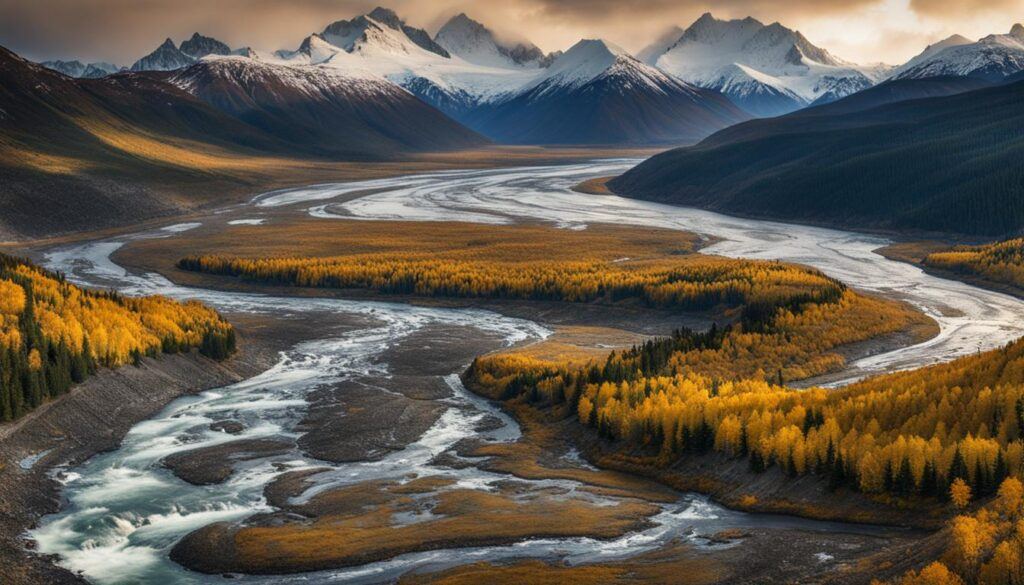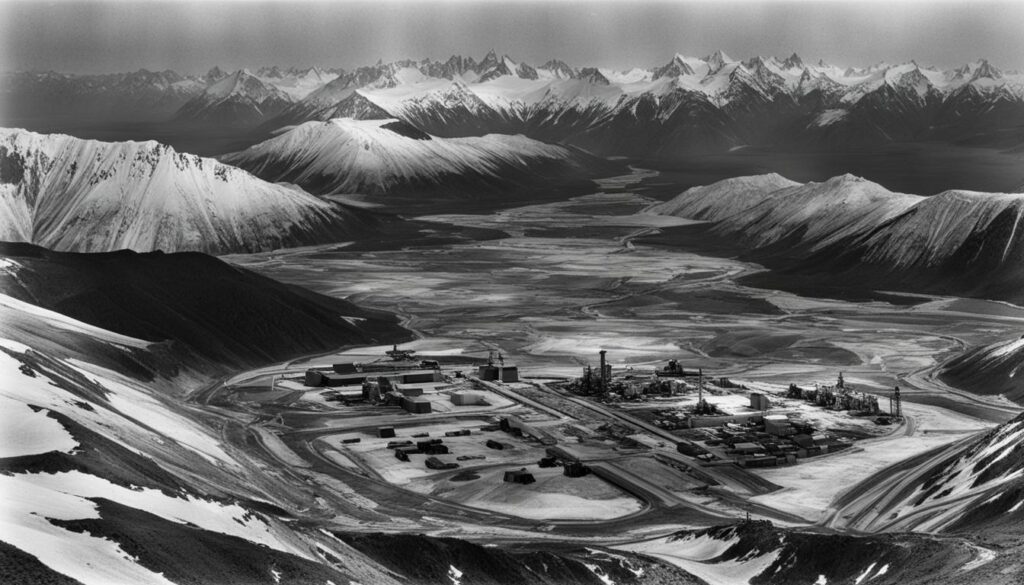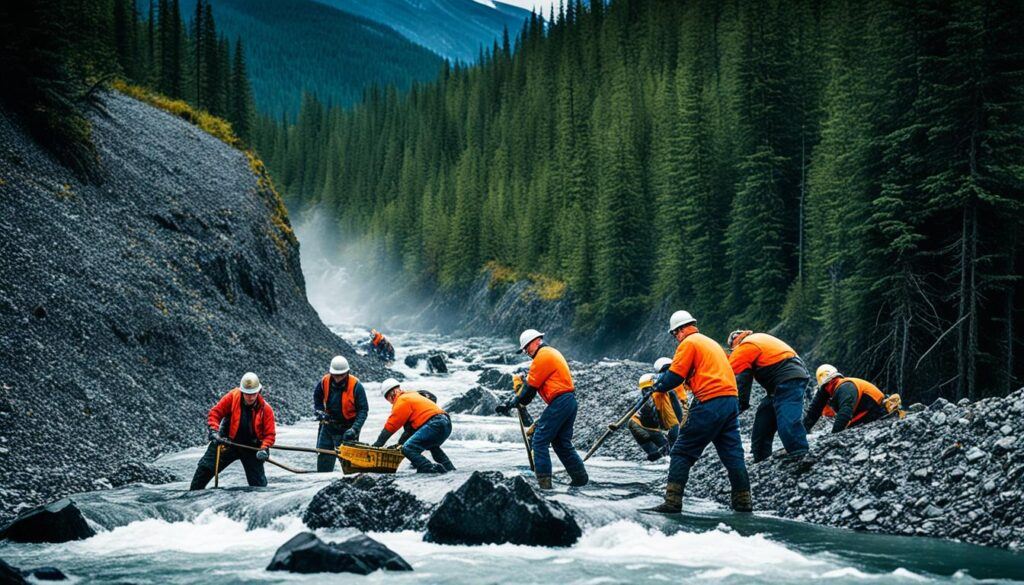Alaska is a treasure trove when it comes to gold, with a rich history of gold mining and abundant reserves. This vast and pristine state has been a hub for gold exploration and settlement since the United States acquired the territory in 1867.
Gold mining initially started in areas near Fairbanks and Juneau, and Nome in 1870. These areas have been the primary sources of gold production in Alaska, which has a long-standing reputation for being a major contributor to the nation’s gold supply. In fact, Alaska accounts for all current gold production in the state.
In 2019, Alaska produced a whopping 539,390 troy ounces of gold, making up 8.4% of the total national production. This impressive output solidified Alaska’s second-place ranking, with only Nevada surpassing it in gold production.
Notably, Alaska is home to seven large-scale hard-rock mines and numerous small-scale operations. Mines like Fort Knox, Pogo, Kensington, Greens Creek, and Dawson contribute significantly to Alaska’s gold production, highlighting the state’s prominent position in the gold mining industry.
Key Takeaways:
- Alaska has a rich history of gold mining, with gold production dating back to the late 1800s.
- In 2019, Alaska produced 539,390 troy ounces of gold, ranking it second in the United States.
- The state is known for its large-scale hard-rock mines, such as Fort Knox, Pogo, Kensington, Greens Creek, and Dawson.
- Alaska’s gold reserves are vast, with gold deposits found throughout the state.
- Gold mining continues to be a significant industry in Alaska, providing employment and contributing to the state’s economy.
Gold Mining in Alaska
Gold mining in Alaska has a long and storied history, dating back to the late 1800s. The state’s abundance of gold reserves and its significant contribution to the overall gold supply in the United States make it a prominent player in the gold mining industry. Alaska is known for its large-scale hard-rock mines, as well as numerous smaller operations, which collectively contribute to the state’s gold production.
In 2019, Alaska produced 539,390 troy ounces of gold, positioning it as a significant contender in the gold mining sector. This output accounted for a notable share of the overall national gold production, solidifying Alaska’s role in the industry.
Some of the key gold mines in Alaska include:
- Fort Knox: Located near Fairbanks, it is one of the largest gold-producing mines in the state.
- Pogo: Situated northeast of Delta Junction, it is operated by Northern Star Resources and contributes to Alaska’s gold production.
- Kensington: North of Juneau, this mine, owned by Coeur Mining, plays a vital role in Alaska’s gold mining industry.
- Greens Creek: Southwest of Juneau, the Greens Creek mine, owned by Hecla Mining, significantly contributes to Alaska’s gold supply.
- Dawson: Another noteworthy gold mine in Alaska, it adds to the state’s overall gold production.
Alaska’s gold mining industry is a crucial component of the state’s economy and continues to thrive, supporting jobs and economic growth. The state’s rich gold reserves and diverse mining operations make it an important contributor to the overall gold supply in the United States.
Gold Reserves in Alaska
Alaska is home to rich and extensive gold reserves, with gold deposits spread throughout the state. The areas near Fairbanks, Juneau, and Nome have historically been the primary sources of gold production in Alaska, attracting prospectors and miners for decades.
These gold reserves in Alaska are vast and diverse, accommodating both large and small-scale placer-gold mines. Placer mining, which involves the extraction of gold from sands and gravels, remains a crucial part of Alaska’s gold industry.
The state’s gold reserves contribute significantly to the gold supply in Alaska and the United States as a whole, supporting the nation’s demand for this precious metal. The abundance of gold deposits in Alaska highlights its importance within the domestic mining landscape.
| Location | Gold Deposits |
|---|---|
| Fairbanks | Placer gold |
| Juneau | Lode and placergold |
| Nome | Placer gold |
| [Other location] | [Gold deposits] |
As shown in the table above, gold deposits are widespread in Alaska, with various locations hosting significant reserves. These deposits attract both large-scale mining operations and individual prospectors who contribute to the overall gold supply.
With its extensive gold reserves and continued mining activity, Alaska plays a crucial role in supporting the gold supply chain, ensuring a steady output of this precious metal.

Quote:
Alaska’s gold reserves are a testament to the state’s rich geological history and hold immense potential for both large-scale and small-scale mining operations. The diversity of gold deposits across various locations ensures a steady supply of this valuable resource, contributing to the overall gold supply in Alaska and the United States.
Gold Production in Alaska
Alaska has a longstanding legacy as a significant producer of gold. In 2019, the state’s gold production reached 539,390 troy ounces, contributing 8.4% to the national total. Although there has been a decline in gold production since its peak in 2013, Alaska remains a vital player in the gold supply chain.
The majority of gold production in Alaska comes from large-scale hard-rock mines. These mines, including renowned ones like Fort Knox, Pogo, Kensington, Greens Creek, and Dawson, are responsible for a significant portion of the state’s gold output. Additionally, there are several small-scale operations that also contribute to Alaska’s gold production.
To illustrate the scale of gold production in Alaska, let’s take a closer look at the 2019 gold production figures:
| Mine | Gold Production (troy ounces) |
|---|---|
| Fort Knox | 144,695 |
| Pogo | 226,716 |
| Kensington | 127,180 |
| Greens Creek | 118,200 |
| Dawson | 9,124 |
Note: The above table represents the gold production from the largest mines in Alaska in 2019.
Despite the declining trend in recent years, Alaska’s gold production continues to make a significant impact on the state’s economy and the overall gold supply. The combination of large-scale mines and smaller operations ensures that gold production remains an integral part of Alaska’s mining industry.
Major Gold Mines in Alaska
Alaska is home to several major gold mines that contribute significantly to the state’s gold production. These mines play a crucial role in Alaska’s thriving gold mining industry, extracting valuable resources and driving economic growth.
One of the notable gold mines in Alaska is the Fort Knox mine. Located in the Fairbanks North Star Borough, this mine is owned by Kinross Gold Corporation. The Fort Knox mine has been in operation since 1996 and has produced significant amounts of gold over the years.
Another significant gold mine in Alaska is the Pogo gold mine. Situated northeast of Delta Junction, this mine is owned by Northern Star Resources. Pogo is an underground mine that began production in 2006 and has contributed to Alaska’s gold production ever since. Its extensive mineral resources make it an essential asset in the state’s mining industry.
The Kensington gold mine is yet another notable gold mine in Alaska. Located north of Juneau, this mine is owned by Coeur Mining. It is an underground operation that commenced production in 2010. The Kensington mine has proved to be a valuable asset in Alaska’s gold production, contributing to the state’s overall output.
Located southwest of Juneau, the Greens Creek mine is a significant gold mine in Alaska. Owned by Hecla Mining, this mine is both an underground silver and gold mine. It has been operating since 1989 and has played a vital role in Alaska’s mining industry, contributing to the state’s gold production.
The Dawson mine is another significant gold mine in Alaska. Although smaller in scale compared to the other mines mentioned, it is responsible for a portion of Alaska’s gold production. The Dawson mine contributes to the state’s overall gold output, showcasing the diversity of Alaska’s gold mining industry.
To provide a comprehensive overview of Alaska’s major gold mines, refer to the table below:
Gold Mine Location Owner Operation Type Fort Knox mine Fairbanks North Star Borough Kinross Gold Corporation Open-pit Pogo gold mine Northeast of Delta Junction Northern Star Resources Underground Kensington gold mine North of Juneau Coeur Mining Underground Greens Creek mine Southwest of Juneau Hecla Mining Underground Dawson mine Not specified Not specified Not specified
These major gold mines in Alaska, along with many other smaller operations, contribute significantly to the state’s gold production. They provide employment opportunities, support local economies, and highlight the importance of the mining industry in Alaska’s overall development.

Advanced Gold-bearing Hard Rock Exploration Projects in Alaska
In addition to the active gold mines, Alaska is home to several advanced gold-bearing hard rock exploration projects. These projects showcase the state’s potential for future gold production and further contribute to its status as a prominent player in the gold mining industry.
Donlin Gold Project
The Donlin Gold project, located in the Kuskokwim Gold Belt, is one of the most significant gold exploration projects in Alaska. It boasts a substantial reserve of gold and is anticipated to become one of the world’s largest gold mines. With promising prospects, the Donlin Gold project holds the potential to make a substantial contribution to Alaska’s gold production in the future.
Pebble Copper Project
Another noteworthy gold exploration project in Alaska is the Pebble Copper project. This project encompasses one of the largest copper-gold porphyry deposits known globally. Its significant mineral resources, including gold, highlight the potential for substantial gold production in Alaska in the coming years.
Niblack Prospect
The Niblack prospect, located on Prince of Wales Island, is a copper-gold-zinc-silver VMS deposit. While primarily focused on the extraction of copper, the Niblack prospect also holds valuable gold resources. This project contributes to the diverse mineral wealth of Alaska and further emphasizes the state’s potential as a key gold producer.
Placer Mining in Alaska
Placer mining is an essential activity in Alaska, contributing significantly to the state’s gold production. These small-scale operations, scattered throughout the region, play a crucial role in extracting gold from the sands and gravels of Alaska’s rivers and streams. While placer mining may not generate a large number of employment opportunities, it remains a seasonal industry that provides valuable jobs for many residents, especially in rural areas. In fact, in 2015, placer gold mining accounted for approximately 120 full-time-equivalent positions in Alaska, helping to support local economies.
Placer mining serves as a vital part of Alaska’s overall gold production. The state’s abundant natural resources and favorable geological conditions make it an ideal location for mining activities. The extraction process involves carefully separating gold particles from other materials, such as sand and gravel, using water and gravity. Placer mining techniques have been refined over the years, allowing miners to effectively recover gold deposits.
Placer mining operations in Alaska often involve the use of simple tools and equipment, making it accessible to individual prospectors and small-scale miners. This industry fosters a sense of independent entrepreneurship, with many individuals staking their claims and embarking on their own mining ventures. These operations contribute to the diversity of Alaska’s mining sector, alongside the large-scale hard-rock mines that focus on extracting gold from ore deposits.
Placer Mining Jobs in Alaska: Supporting Local Communities
Placer mining not only contributes to Alaska’s gold production but also plays a vital role in supporting local communities. The jobs created by placer mining operations provide income and economic stability for individuals and families in rural areas. These employment opportunities often emerge during the mining season, attracting workers from different backgrounds and skill sets.
Despite the relatively small number of jobs in placer mining compared to other industries, the seasonal nature of these positions allows local residents to supplement their income and support their communities. Placer mining jobs often provide individuals with flexible work schedules, allowing them to engage in other activities and pursue alternative sources of income during the off-season. This adaptability is a significant advantage for those residing in remote areas of Alaska.
Moreover, the ripple effect of placer mining extends beyond direct employment. It stimulates economic growth within rural communities by creating demands for goods and services, such as equipment, supplies, transportation, and hospitality. These local businesses thrive during the mining season and provide further support to the region’s economy.
Placer mining jobs offer individuals the chance to experience the unique lifestyle of Alaska’s mining communities. Miners often work in close-knit teams, fostering camaraderie and a shared passion for the pursuit of gold. The bonds formed during the mining season contribute to the tight-knit fabric of these communities.
| Year | Placer Gold Production (troy ounces) |
|---|---|
| 2015 | 60,700 |
| 2016 | 56,000 |
| 2017 | 59,000 |
| 2018 | 54,300 |
| 2019 | 52,000 |
Source: Alaska Department of Natural Resources
Despite fluctuations in placer gold production, the industry remains a vital component of Alaska’s mining sector. While technological advancements and changes in the gold market may influence the dynamics of placer mining, the commitment of those involved in this traditional form of gold extraction continues to contribute to Alaska’s rich mining heritage.

Historical Gold Mines in Southeast Alaska
Southeast Alaska has a fascinating history of gold mining, with numerous historical gold mines dotting the region. These mines bear witness to the wealth of gold that has been extracted from the area over the years, leaving behind a rich mining legacy.
The Porcupine District
One notable district in Southeast Alaska is the Porcupine district, situated near Haines. This district has witnessed the production of over 81,000 troy ounces of placer gold. Placer gold refers to the gold found in stream beds or gravel deposits, and the Porcupine district has been a fruitful source of this precious metal.
The Juneau District
The Juneau district, encompassing the city of Juneau, holds significant historical importance in gold mining. It has yielded over 7 million ounces of lode gold and 80,000 troy ounces of placer gold throughout its history. Lode gold refers to gold found within rock formations, and the Juneau district has been a prolific source of both lode and placer gold.
The Admiralty District
Located on Admiralty Island, the Admiralty district has been primarily involved in silver and base metal mining. However, the extraction of these metals often yielded gold as a valuable byproduct. Although not the district’s primary focus, the production of gold in the Admiralty district has added to the overall mining activity in Southeast Alaska.
These historical gold mines in Southeast Alaska offer a glimpse into the region’s mining past and the significant role it has played in the gold mining industry. The Porcupine district, the Juneau district, and the Admiralty district each showcase unique characteristics and contributions to Alaska’s rich mining history.
Explore and learn more about these remarkable historical gold mines and the stories they hold.
Current Gold Mining Industry in the US
Gold mining plays a crucial role in the United States, with several states contributing to the country’s overall gold production. Among these states, Nevada takes the lead as the top gold mining state in the US, followed closely by Alaska, Colorado, California, and Arizona. Together, these states have a long-standing history in the gold mining industry and continue to be major players in the field.
In 2018, the United States produced a total of 210 metric tonnes of gold, with Nevada alone contributing a staggering 75% of that total. This highlights the significance of Nevada’s gold mining industry in the country’s overall gold supply. The state is home to world-renowned mines such as Goldstrike, Cortez, and Carlin, solidifying its position as the leading gold mining state in the US.
While Nevada takes the top spot, Alaska remains a prominent player in the gold mining industry. With its rich history of gold production and vast gold reserves, Alaska stands as the second-largest gold mining state in the US. The state is home to several large-scale hard-rock mines, including Fort Knox, Pogo, Kensington, Greens Creek, and Dawson, contributing significantly to Alaska’s gold production and the nation’s overall gold supply.
The gold mining industry in the US continues to thrive, providing economic opportunities and ensuring a steady supply of gold. These top gold mining states, along with other states across the country, contribute to the vibrant and dynamic gold mining industry in the United States.

| State | Gold Production (2018) |
|---|---|
| Nevada | 170 metric tonnes |
| Alaska | 21 metric tonnes |
| Colorado | 11 metric tonnes |
| California | 9.8 metric tonnes |
| Arizona | 9 metric tonnes |
Nevada – Top Gold Mining State in the US
When it comes to gold mining in the United States, Nevada takes the crown as the top gold mining state. With its abundance of large-scale mines and significant gold reserves, Nevada has firmly established itself as a leader in the industry.
Some of the most prominent gold mines in Nevada include the Goldstrike, Cortez, and Carlin Gold Mines. These mines are not only key players in the state but also rank among the top 10 gold mines in the entire world. They are instrumental in Nevada’s position as the leading gold mining state.
In 2018 alone, Nevada produced a staggering 170 metric tonnes of gold, making it the highest producer among all the states in the US. This impressive production further solidifies Nevada’s significance in the gold mining industry.
What sets Nevada apart is not only its gold production but also its vast reserves. With such rich resources, the state continues to attract mining companies and investors from around the globe. Nevada’s gold reserves play a vital role in maintaining the state’s prominent position as a hub for gold mining.
| Year | Gold Production (metric tonnes) |
|---|---|
| 2018 | 170 |
| 2017 | 211 |
| 2016 | 173 |
The table above showcases Nevada’s gold production in recent years, emphasizing its consistent high output. These numbers highlight the state’s importance in the gold mining industry and its contribution to the overall gold supply.
With its top-ranking gold mines and substantial reserves, Nevada shines as the premier gold mining state in the US. Its ongoing success in gold production cements its position as a vital player in the industry and a significant contributor to the nation’s gold supply.
Alaska – A Significant Gold Mining State
Alaska stands as one of the most important gold mining states in the United States, boasting a rich history of gold production and vast reserves. With a production of 539,390 troy ounces in 2019, Alaska ranks second only to Nevada in terms of gold output. The state is renowned for its large-scale hard-rock mines, including Fort Knox, Pogo, Kensington, Greens Creek, and Dawson, all of which greatly contribute to Alaska’s gold production. These mines, along with various small-scale operations, create a thriving gold mining industry in the state.
Moreover, Alaska is home to extensive gold reserves, with exploration and mining activities widespread. Placer mining, which involves extracting gold from sands and gravels, is an active industry in Alaska. The state’s gold reserves play a critical role in maintaining the overall gold supply in the United States, contributing significantly to the nation’s gold resources.
As an integral part of Alaska’s economy, gold mining provides numerous employment opportunities and economic benefits to the state’s residents. The industry’s continued growth and success further solidify Alaska’s position as a crucial player in the gold mining sector.
To illustrate the significance of Alaska’s gold mining industry, let’s take a closer look at some of the state’s prominent gold mines and their contributions to the overall gold production.
| Gold Mine | Location | Ownership | Gold Production (2019) |
|---|---|---|---|
| Fort Knox | Interior Alaska | Kinross Gold Corporation | 200,846 troy ounces |
| Pogo | Northeast of Delta Junction | Northern Star Resources | 213,448 troy ounces |
| Kensington | North of Juneau | Coeur Mining | 127,914 troy ounces |
| Greens Creek | Around Juneau | Hecla Mining | 130,368 troy ounces |
| Dawson | Yukon-Tanana Upland | Gold Torrent | 5,500 troy ounces |
This table showcases the significant gold production from some of Alaska’s prominent gold mines. These mines collectively contribute to Alaska’s overall gold output, highlighting their importance to the state’s mining industry.
Alaska’s prominence as a gold mining state is further enhanced by its vast reserves, fruitful exploration projects, and the continuation of placer mining. With its rich mining heritage and ongoing production, Alaska’s gold mining industry remains a cornerstone of the state’s economy and a critical contributor to the US gold supply.
Quote:
“Alaska’s gold mining industry exemplifies the state’s rich history and significant contributions to the overall gold production in the United States. The abundance of gold reserves and the presence of large-scale mines make Alaska a vital player in the mining sector.” – Mining Expert
Conclusion
Alaska holds a prominent position in the gold mining industry in the United States, boasting a rich history of gold production and vast reserves. The state’s gold mines, both large-scale and small-scale, have made significant contributions to Alaska’s overall gold production, which reached 539,390 troy ounces in 2019. With its second-place ranking, Alaska continues to be a major player in gold production, trailing only behind Nevada, the top gold mining state in the US.
The abundance of gold reserves and the thriving mining industry in Alaska underline the state’s importance in meeting the gold supply demands of the United States. The presence of acclaimed gold mines such as Fort Knox, Pogo, Kensington, Greens Creek, and Dawson further solidifies Alaska’s standing in the industry. These mines, alongside various other operations, collectively contribute to the state’s flourishing gold production.
Alaska’s gold mining industry not only generates significant economic opportunities but also plays a pivotal role in driving the state’s economy forward. The industry’s continued growth and success contribute to job creation, revenue generation, and the overall prosperity of Alaska. As gold remains a valuable and sought-after resource, Alaska’s position in the gold mining industry is invaluable.
FAQ
How much gold is left in Alaska?
The exact amount of gold reserves in Alaska is difficult to determine, but the state is known for its rich gold deposits. These reserves are spread throughout the state, with areas near Fairbanks, Juneau, and Nome being primary sources of gold production.
What is the current gold production in Alaska?
In 2019, Alaska produced 539,390 troy ounces of gold, accounting for 8.4% of the total national production. The state’s gold production comes from large-scale hard-rock mines and numerous small-scale operations.
What are some major gold mines in Alaska?
Alaska is home to several major gold mines, including the Fort Knox mine, Pogo gold mine, Kensington gold mine, Greens Creek mine, and Dawson mine. These mines contribute significantly to Alaska’s gold production.
Are there any advanced gold exploration projects in Alaska?
Yes, there are several advanced gold-bearing hard rock exploration projects in Alaska. Some notable projects include the Donlin Gold project, Pebble Copper project, and Niblack prospect. These projects highlight the potential for future gold production in the state.
What is placer mining and is it still active in Alaska?
Placer mining is the process of extracting gold from sands and gravels. It is still an active industry in Alaska, with many small-scale operations scattered throughout the state. Placer mining continues to contribute to Alaska’s overall gold production.
Are there any historical gold mines in Southeast Alaska?
Yes, Southeast Alaska has a rich history of gold mining. The Porcupine district, near Haines, and the Juneau district, which includes the city of Juneau, were significant gold mining areas. The Admiralty district on Admiralty Island also produced gold as a byproduct of silver and base metal mining.
How does Alaska’s gold production compare to other states in the US?
Alaska ranks second in gold production among the US states, with Nevada being the top producer. However, Alaska’s gold production remains a significant contributor to the overall gold supply in the United States.
What is the current status of the gold mining industry in the US?
The gold mining industry in the US is vibrant, with several states contributing to the overall gold production. Nevada is the top gold mining state, followed by Alaska, Colorado, California, and Arizona. These states have a long history of gold mining and continue to play important roles in the industry.
Is gold mining in Alaska economically important?
Yes, gold mining in Alaska is economically important. It provides employment opportunities and contributes to the state’s economy. The industry supports both large-scale and small-scale operations, which generate revenue and stimulate local economies.



